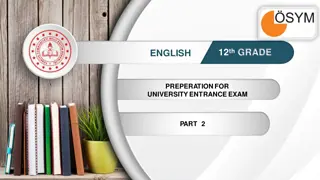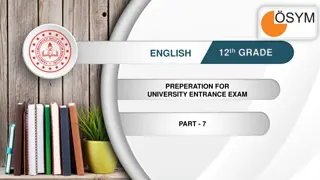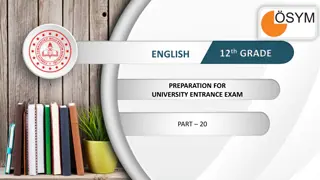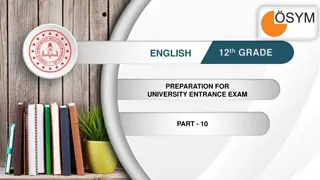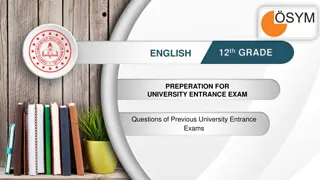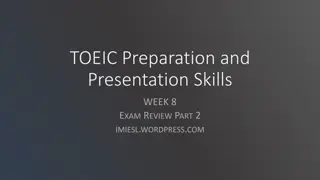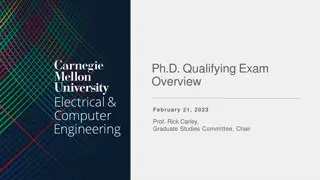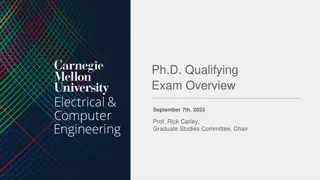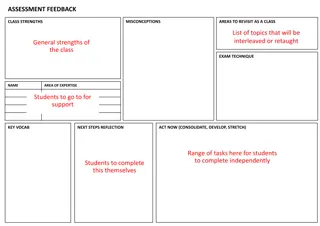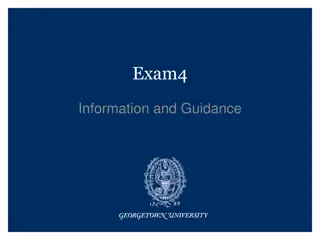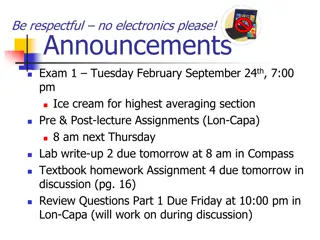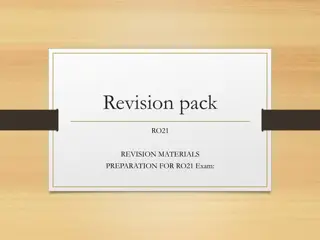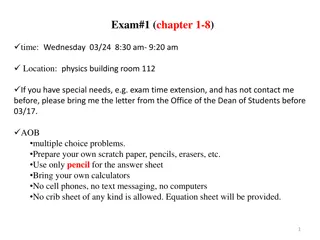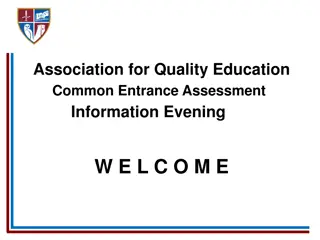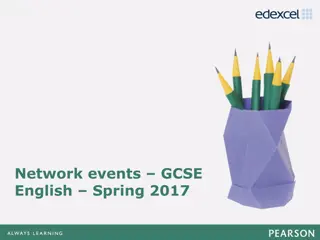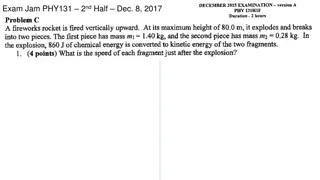Understanding Various Topics in 12th Grade English Preparation for University Entrance Exam
Explore important concepts such as ocean currents, effects of space travel on the human body, consequences of hitting the snooze button, and the impact of national boundaries on African tribes. Enhance your knowledge for the 12th-grade English examination with in-depth analysis and critical thinking.
Download Presentation

Please find below an Image/Link to download the presentation.
The content on the website is provided AS IS for your information and personal use only. It may not be sold, licensed, or shared on other websites without obtaining consent from the author. Download presentation by click this link. If you encounter any issues during the download, it is possible that the publisher has removed the file from their server.
E N D
Presentation Transcript
12th GRADE ENGLISH PREPARATION FOR UNIVERSITY ENTRANCE EXAM PART - 9
PART PART- -9 9 12th Grade English Sorularda, bo b rak lan yerlere par alarda anlam b t nl n sa lamak i in getirilebilecek c mleleri bulunuz. 1. Between Greenland and Norway, the Gulf Stream waters begin a journey into the depths. Along the way, the water is sharply cooled by frigid winds from the North Pole, and its salt content increases due to the formation of sea ice. Both factors raise the water s density as well as its weight ---- There, it flows at great depths toward the southern end of the Atlantic. A) After its long journey, through the depths, water rises to the surface again. B) The heavier water sinks through layers of lighter water in the polar zone until it reaches the seafloor. C) Surface currents in the oceans are driven by the prevailing winds. D) Cold ocean currents near the shore lead to the development of coastal deserts. E) The Gulf Stream splits into smaller circulating currents on its way across the Atlantic.
PART PART- -9 9 12th Grade English 2. You might have thought from watching videos of astronauts aboard the International Space Station (ISS) that spaceships were pretty benign environments. Floating around in microgravity looks like a lot of fun. As you are isolated from the rest of the human population, you are effectively quarantined against catching flu or any other transmissible disease. But in fact, space is pretty harmful to the human body ---- Therefore, travelling beyond the planet has a number of negative effects on the body and mind which need to be overcome for long-duration missions in the future. A) We have evolved as social animals under the conditions on the Earth. B) The solution might be to generate artificial gravity on space. C) Special medication can be given in small amounts to protect the body. D) In the future astronauts will be able to stay in space for longer periods. E) More research is needed to identify the exact negative effects.
PART PART- -9 9 12th Grade English 3. Many people believe that the snooze button on your alarm clock helps wake you up, but is this true? Here s a reason to jump out of bed on the first alarm. Not only can hitting snooze make it more difficult to wake up because you begin to enter a new sleep cycle, this fragmented sleep also makes you feel sleepier during the day as it is less restorative than uninterrupted sleep ---- Thus, hitting the snooze button makes it more difficult to wake up than if you had risen with your first alarm. A) Entering a new sleep cycle and then waking again soon after can cause that feeling of laziness when we are half asleep. B) Research has shown that sleeping for only four hours for six nights in a row can increase stress and blood pressure. C) The tendency that young people have to sleep late and then reluctantly get up for school is a common habit among teenagers. D) Though much has been discovered about the science of sleep, more research needs to be carried out to better understand it. E) Less sleep may help us find more hours in the day, but it will take its toll on our health.
PART PART- -9 9 12th Grade English 4. There are more than 600 ethnic or tribal groups in Africa, and only 53 countries. Many of today s national boundaries were created in the late 19th century by colonial rulers. ---- As a result, tribes are often split between different countries. The Ewe people, for example, are divided between Ghana and Togo. After independence, it has often proved difficult to create unity among the different peoples in one country. A) Africa is home to about 849 million people more than one in eight of the world s population. B) Also, groups of nomadic people, who tend to roam together across many countries, are found throughout western Africa. C) The most heavily urbanized region in Africa is northern Africa, and Cairo, in Egypt, is the largest city on the continent. D) Borders sometimes follow natural features, such as rivers, but often they just follow straight lines on a map. E) The war between the Hutu and Tutsi peoples has forced thousands of people to leave their homes.
PART PART- -9 9 12th Grade English 5. Plants and livestock need air, water, and nourishment to stay alive. If a plant does not have the kind of soil it needs, it may die. Similarly, animals also need to have the right climate and the right food to survive. Farmers try to raise the kinds of livestock and plants that will do well in their particular region. ---- For example, many farmers in dry areas use irrigation, or artificial watering. A) Farmers raise crops and livestock in every climate and in all kinds of different soil. B) Plants and animals also supply such natural materials as cotton, flax, wool, and hides. C) Agriculture provides the food and many of the raw materials that humans need to survive. D) Some regions receive a lot of sunlight or rainfall while others have colder or drier weather. E) If they do not have perfect natural conditions, they try to create the best conditions possible.
PART PART- -9 9 12th Grade English 6. Women are roughly twice as likely as men to suffer from stress-related psychiatric disorders, according to epidemiological analyses. The big question has always been: Why? Some experts argue that cultural factors are at least partly responsible. For instance, women may be more willing than men to seek help for mental illness, making their cases more likely to be counted. ---- Scientists are uncovering telling differences in the ways that male and female brains react and adapt to stress. A) But new evidence from research suggests that biology may also play an important role. B) However, scientists have studied more males than females even when investigating disorders. C) Also, it is not only the stress-related disorders that are more prevalent among women than men. D) Similarly, animal studies have revealed significant differences in stress responses. E) In fact, research has linked uncontrolled stress to a wide range of mental health problems.
PART PART- -9 9 12th Grade English 7. Forests, conserved land, and natural habitats are not important just for the sake of saving trees and animals. Forests and all greenery are important in keeping the climate in check. Plants take in the carbon in the atmosphere and give back oxygen, and older trees hold on to that carbon, storing it for the duration of their lives. By taking in carbon dioxide, they are reducing the greenhouse effect. ---- And now, deforestation is responsible for about a quarter of greenhouse gas emissions. A) In other words, greenhouse gases trap heat in the Earth s atmosphere, which increases global average temperature. B) Unfortunately, many of the world s forests have been cut down to make way for farmland, highways, and cities. C) Yet, some countries have chosen sustainable development plans instead of economic plans that would produce greenhouse gases. D) In fact, it is not only the trees and oceans that store carbon, soil does, too, and by exposing the carbon to the oxygen in the air, it helps to produce carbon dioxide. E) Although the soil on a treeless hillside washes away in a mudslide, a tree-covered hillside s soil stays put.
PART PART- -9 9 12th Grade English 8. Microwave ovens do not directly cook food; what they do is heat water. The frequency of microwaves happens to be just right for exciting water molecules ---- Nearly all food contains water, but microwaves will not cook completely dry food like cornflakes, rice or pasta. A) Microwaves are a form of electromagnetic radiation that sits on the spectrum between radio waves and infrared light. B) By spreading their energy evenly through food, the microwaves heat the water in it and the hot water cooks the food. C) Microwave cookery is similar to heating food in a normal oven, except that the microwaves penetrate deeper and more quickly. D) The molecules in the centre of your soup are not heated any quicker than those on the outside. E) Exciting the water molecules means that the food rarely gets much hotter than 100 C, at which water boils.
PART PART- -9 9 12th Grade English 9. A scientist at Japan s Osaka University built a robot for one purpose: to pretend to listen to you. When two or more are placed together, they will simulate people having a conversation. If a human attempts to join in, the robots will smile, nod, and respond to comments by saying things like "I see" or "interesting point". They will not actually understand what has been said, but will appear to. ---- But the motivation behind the robot was to try and model the subtle body language and polite niceties that are so important to conversation. A) This is, of course, an entirely pointless achievement. B) Robots that seem more human and less intimidating are being built. C) Equally important for roboticists is an understanding of human psychology. D) The team hope to make robots with more realistic behaviours. E) There must be a balance between the psychological and the scientific when building a robot.
PART PART- -9 9 12th Grade English 10. Following the last Ice Age, humans had to adapt their diet and ways of life. While mobility was usual, in favourable areas with exceptional resources, communities could become settled. Hunter- gatherers used a wide variety of foods. ---- For example, herd animals moved between summer upland and winter lowland pastures, marine fish and birds migrated seasonally, and woodlands produced autumn fruits and spring bulbs. However, other food sources, such as shellfish, small mammals, and freshwater fish, could be found all year round. A) Bones and shells recovered from archaeological sites are the most obvious remains of what hunter-gatherers ate. B) In some favoured regions, early humans could remain in one location with abundant resources. C) Hunter-gatherers in warmer areas often hunted gazelle, the most common mammal in the region. D) In most regions, some foods were available in different places at certain times of year. E) Hunter-gatherers selected environments offering a diversity of food sources, such as lakes, rivers and coasts.
PART PART- -9 9 12th Grade English 11. The coffee tree is an evergreen. It grows in about 70 countries that offer suitable climates and altitudes.---- They are picked from the tree during harvest they contain two seeds, which after processing become coffee beans. The main commercially grown coffee tree species are Arabica and Robusta. While Robustas are high-yielding and resistant to pests and diseases, producing coffee cherries with rustic flavour, Arabicas are generally superior in flavour. A) As botanists discover new species with interesting flavours, the family tree of coffee continues to grow. B)The trees are cultivated with care, and grow for about 3-5 years before they flower and produce fruit, known as coffee cherries. C) The movement of hot and cold air influences how the coffee cherries mature and taste. D) Many coffee varieties are genetically similar, but have acquired different regional or local names. E) The look and flavour of coffee are influenced by many forces, such as soil, sun exposure and rainfall patterns.
PART PART- -9 9 12th Grade English 12. Proteins are involved in many vital cellular chemical reactions. Some proteins provide the cell with its structural elements, whereas others make muscles contract, and enable movement. Scientists have identified 20 amino acids as being the essential components that make up all proteins. ---- So, the proteins of one species differ from those of another, and within a single organism, the proteins of one organ differ from those of other organs. A) Aside from their biological role in making proteins, amino acids are used for other purposes. B) Some active agents found in soaps and shampoos, for example, are derived from amino acids. C) Muscle proteins such as myosin outnumber any other type of protein in mammals. D) They have also faced several challenges in terms of classifying proteins. E) Proteins, on the other hand, are extraordinarily diverse in their structures and functions.
PART PART- -9 9 12th Grade English 13. Nigeria is potentially the richest nation in Africa, with huge reserves of oil, natural gas, coal, tin, and iron ore. ---- However, corruption and bad government have meant that the money earned from these natural resources has not been used properly, and most Nigerians remain very poor. A) This country has also been affected by drought, crop failure and over-farming. B) Efforts were made to develop other products so that Nigeria s economy was not so dependent on oil. C) The oil industries of Cameroon and the mineral mines of Congo employ thousands of people as those of Nigeria do. D) In addition, Central Africa is a hugely fertile region, with abundant grasslands and lots of rivers. E) It also has abundant fertile land, capable of growing cotton, coffee, sugar and many other crops.
PART PART- -9 9 12th Grade English Thanks for your participation


